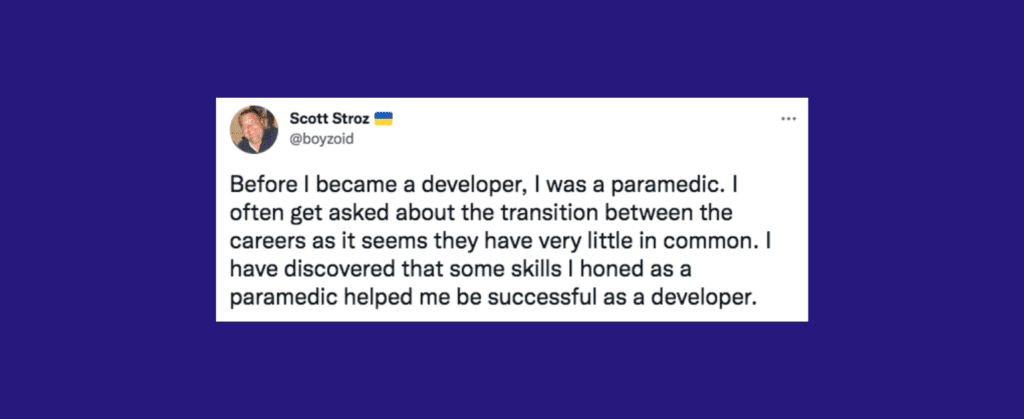The tech industry is full of exciting and lucrative career opportunities, but if you’ve never worked in IT and you have no relevant experience, breaking into tech might feel like a pipe dream.
I’m here to tell you that it doesn’t have to be. Plenty of people have broken into tech despite having no experience and, if you’re willing to do the work, I’m sure you can too. 💪
In this post, I’m going to explain how to get into tech and land your first tech job with no experience. I’ll share 16 ways you can use your seemingly unrelated skills and experience, and gain new ones, to land a job in the tech industry.
I’ll also introduce you to people from all kinds of backgrounds who successfully figured out how to get into tech with no experience.
This post is sponsored by Flatiron School. They have a proven track record of helping people switch into tech with their in-person and online bootcamps.
You can streamline your journey into tech by joining one of their programs to learn software engineering, UX/UI design, or data science in just 15 weeks. Then, learn how to get a tech job and launch your new career with one-on-one support from their dedicated career coaches.
Flatiron backs it all up with their money-back guarantee—get a job in tech, or receive your tuition back (see details). 🎉
Whether a bootcamp is right for you or not, the tips below will help you get into the tech industry even if you have no relevant experience.
Let’s do this! 👇
1. Apply for a tech job in a field you have experience in
It’s the 21st century, so just about every type of company is using tech in some capacity!
Breaking into tech with no experience is so much easier when you already have familiarity with a particular industry. Having this familiarity gives you a chance to provide value to the company beyond the raw tech.
➡️ Flatiron School grad Karla R. went from finance to Blockchain Developer in the FinTech industry. Karla had a successful career working in several different roles at Visa, but felt ready to take on new challenges and wanted more creativity and excitement in her life by working in a startup environment.
After attending Flatiron School, she’s now a Systems Consultant for a blockchain technology startup, leveraging her background in finance for a new, dynamic career in tech.
➡️ Ina Yulo began her career in advertising but when she noticed that the best-paying marketing roles were at tech companies, she transitioned to a career in tech and FinTech more specifically. When I interviewed her, she told me that most of her FinTech connections came from banking backgrounds.
And if finance doesn’t light you up, once you’ve got some tech experience under your belt, you can transition into a tech role outside of the finance sector. 🎉
Of course, finance isn’t the only industry you can do this with.
Here’s how to get into tech via other industries you may have experience in:
| PREVIOUS ROLE | INDUSTRY | EXAMPLES |
|---|---|---|
| 🎓 Teacher | EdTech | Companies like the course platform Coursera or Nearpod, which combines VR and AR technology with traditional lesson plans |
| 🔬 Scientist, researcher, pharmacist | BioTech | An example is 23andMe, where the labs will test DNA you submit to tell you your ancestry, health reports, help you find and contact DNA relatives, and more |
| 🏥 Doctor, nurse, dentist, fitness professional, therapist | HealthTech | Tempus creates data-harnessing technology to personalize cancer treatment using genomic sequencing, clinical data structuring, image recognition, biological modeling and other means; NurseGrid helps nurses manage their shifts |
| 👚 Fashion/beauty | FashionTech or wearable tech | Fitbit lets users track activities with a fitness wristband; Perfitly uses 3-D visualization so shoppers can see how a garment will fit and look on their bodies before buying |
| 🌎 Environmentalism / conservation / manufacturing | CleanTech or GreenTech | The former helps businesses reduce waste and make more eco-friendly products (e.g. Proterra zero-emission buses); the latter is more focused on things like renewable energy and recycling (e.g. bio-bean, which transforms used coffee grounds into other products like biofuels) |
| 🍔 Catering / hospitality | FoodTech | Disrupting how food is selected, preserved, processed, packaged, sold and distributed, like Winnow Solutions, which helps companies run a more efficient and sustainable kitchen by automating food waste capture using AI |
| 🏠 Real estate agent, mortgage advisor | Real estate technology | Companies like Zillow that facilitate property buying, renting, and home loans |
| 🛡️ Insurance | InsurTech | Companies like Dinghy, which provides business insurance for freelancers, or Tractable, which uses AI to settle accident claims faster |
| 📜 Lawyer, paralegal, regulator | RegTech or LegalTech | The use of new technology to facilitate the delivery of legal services and regulatory requirements. For instance, Casetext, a machine learning startup, is a tool for lawyers to help with faster research, drafting, and more |
| ✈️ Travel agent, hotel worker, air steward | TravelTech | Tons of companies, from large ones like TripAdvisor and AirBnB to small ones like Upside for business travel and GPSmyCity which helps travelers discover hidden gems on self-guided walks |
There are so many crossover options to explore!

➡️ Career changer Debby Albert went from graphic design to advertising to merchandising to heading up creative departments to now working as a UX strategist full-time at the age of 58. “Leverage your past experience in any way you can,” she advises. “You might be surprised at how much you already know.”
And don’t limit yourself to industries you’ve worked in professionally. Make a list of all the industries, areas, hobbies where you’ve spent time, particularly those you enjoyed.
Use your experience in those areas to get your foot in the door, even if you start small like building websites on a freelance basis for people in the industry or hobby you’re trying to specialize in.
On a similar note, you might be able to break into tech via the company you already work for. If your company is supportive, and you’re developing tech skills and showing an interest in working in another department, they might consider moving you to a different team to fill a role instead of hiring someone new.

☝️ Back to top
2. Get your foot in the door with a non-technical role at a tech company
This is kind of the flip side of #1! Instead of looking for a tech role at a non-technical company, you could get your foot in the door at a tech company in a non-technical role.
Research from Glassdoor tells us that 43% of roles advertised by tech companies (around 53,000 positions!) are non-technical. Examples of these types of jobs include customer support, marketing, accounting, product management, sales development, research analysis, recruiting…really anything!
This gives you a chance to get to know people at the company, potentially work with other departments, gain familiarity with the products, and look for opportunities to transition into the tech side as you gain skills.
➡️ Samit Saini started out as a security officer at London Heathrow airport, became a customer service apprentice, and then saw a need. He decided to build an app to digitize Heathrow’s paper-based processes, got more involved in the tech side of his department, and eventually became the IT Solutions Specialist.
➡️ Kristen Kozinski wanted to work for MailChimp, but didn’t have the experience. She got a job working in their support team and later transferred, first to the deliverability team, and then to the information security team.
Just as non-technical companies hire people for tech roles, tech companies hire people for non-tech roles. If you can get hired with your existing skill set, you might be able to transition into a more technical role later on.

3. Showcase your soft skills
A company can always train employees to improve on “hard” skills like a coding language, but soft skills rely more on personality qualities that are more built into each person. Emphasize them in interviews and applications when possible.
➡️ Flatiron School grad Victoria Thevenot graduated college with a degree in English. After Flatiron School, she now works as Lead Ad Developer at New York Magazine. While you might not think an English degree would help in a tech job, it actually gave her an edge over the competition.
During her time pursuing a non-tech college degree, she was unintentionally honing a variety of soft skills that transferred to her new tech role, including communication skills, processing and synthesizing information effectively, and breaking down problems into smaller pieces.

You can do the same with your qualities, e.g. attention to detail, reliability, etc. Think about past performance reviews and good things past supervisors and coworkers have said about you.
You can also think about the soft skills and qualities that are important in the industries you’ve already worked in.
For example, if you’ve worked in hospitality, you’re likely to have good customer service, communication, and presentation skills. If you’ve worked in manufacturing, you might be good with processes, efficiency, and logistics.
Identify and highlight the skills you’re bringing to the table. You know the lingo, the market, and the things people care about there. All of this gives you an edge in the application process, from cover letters to interviews.

Think about how these skills might be useful in a tech role, or which tech roles they might be most useful for. For example, with customer service skills, perhaps you could get into tech via a customer service or tech support role at a software company.
Then it’s a case of showcasing your skills, passion, knowledge, and personality throughout the hiring process.

4. Reverse engineer your skill set
When people ask me how to start a career in IT or tech, I always recommend working backwards from their dream job, if possible.
This move requires some serious long-term thinking though, because you’ll need to have a goal in mind before you get too deep into your learning journey.
If you’re not sure which job you’d like to aim for, check out these resources:
- 18 In-Demand Technology Skills
- 8 Best-Paying Jobs in Technology & What They Involve
- Tech Jobs that Require Little Schooling
- 14 Different Tech Careers That Could Be Your Next Job
- LTCWM career guides
Once you have a particular career or job in mind, take a look at job openings for your dream tech roles on sites like Indeed or LinkedIn.
In particular, look at the skills, experience, and education requirements. Then, start a list of the things you’ll need to learn and accomplish to qualify for your ideal roles.
Dedicate a certain amount of time every day/week to develop the skills you need. Be aware of your weaknesses/gaps and fill or address them as best you can.

5. Revamp (or start) your LinkedIn profile
A big mistake lots of people make when trying to break into a new career is not getting their LinkedIn profile up-to-date and optimized for their target role.
87% of recruiters say they use LinkedIn to find candidates, so being on it is a must! Here are 11 more reasons why you should be on LinkedIn as an aspiring techie.
You don’t actually need to be an expert (yet) to get the attention of recruiters and hiring managers. You just need to position yourself well to look like a good hire.
Prune and refine your experience and make it sound as applicable as possible to the new industry by focusing on transferable skills. Add any new skills or courses, volunteering, etc. Remove any jargon from your previous industry if it might confuse tech recruiters/employers.
Use this LinkedIn profile checklist to make sure you’re covering everything important!
👀 If you’re worried about your current employer seeing you’re heading for a career change, change your settings to limit what they see, by going to Me > Settings & Privacy.
Download the LinkedIn profile checklist
Created with aspiring techies in mind.
6. Do an internship
One way to land a tech job with no formal experience in the tech industry is by collecting smaller pieces of experience to demonstrate your skills. You don’t need to have a relevant career or full-time job on your resume; short-term or part-time internships look good too.
➡️ Even though Marie Armstrong graduated with a degree in Business and Management Information Systems, she had several internships in different areas, including financial software, marketing, and technical project management—eventually landing a full-time job at Microsoft as a technical account manager.
You don’t have to be in college or a new grad to break into tech this way—there are “adult internships” out there. It might not sound glamorous, but it can be a great stepping stone that’s worth considering as you figure out how to get into tech.

There are several avenues you can explore when it comes to finding internship opportunities that will help you break into tech.
Look on online job boards, reach out to people you know and ask if they know of any internships that are available, or even contact your alma mater. You can also search for opportunities within your current company or field; if you’re in marketing, it might be easier to make a career change into tech within the marketing industry.
Consider joining professional associations for your field or the field you want to enter. These groups can provide access to internships and other jobs. Plus, you might get to meet other career-changers who can explain how to get into IT.
☝️ Back to top
7. Volunteer
The function of volunteering is similar to an internship. The main difference is that these opportunities will always be unpaid and typically have fewer hours.
The good news is, you can volunteer on the side (like on weekends) to help ease into your tech transition by building experience and portfolio projects.
Try to volunteer in a way that aligns with your future goals. What industry are you interested in beyond just “tech”? Do you want to work for a software startup? In the FinTech industry? At the intersection of fashion and technology? Look for volunteer opportunities in that specific space. It could be at a nonprofit or any type of business.
If you don’t see any open volunteer positions, offer tech-related help to a small business in your desired (or current) industry. They might appreciate the help and it’ll serve as a great resume-booster. For example, if you’re already working in finance (or want to break into FinTech), you could offer to build a website for a local accounting firm.
You could also ask your friends or family if they need tech help (e.g., building a website), or know someone who does. Look at your hobbies and passions, too: if you have dogs, find a dog shelter without a website and offer to build it for them. Now you have something in your portfolio you can use to start landing web dev gigs for other companies.

8. Start a side gig
There are so many benefits to working tech side gigs as part of your transition into the tech industry! You can make money, try out different types of jobs before you commit to a career track, build industry connections, and much more.
➡️ Joe Previte, who was previously an English teacher, was able to make $5,000 in his first year of learning to code by taking on side gigs after leaving his graduate school program. This allowed him to build up his resume as he figured out how to get into the tech industry. Now, he works as a full-time front-end developer.
There are tons of different kinds of tasks and responsibilities you can take on in the field as a tech side gig (not just building websites). There are so many options. Here are just a few.
- Technical writing
- User experience testing
- Website maintenance
- STEM tutoring
- Virtual assistance
- Tech support
If possible, you want to go after side gigs that align with your past experience (skills and industry) because it makes it faster and easier to land something. However, you also want to consider your future goals and what you’re passionate about. The right gig will help you learn how to work in tech roles like the one you’re aiming for, so the more aligned your side gig is with your dream career, the better.
I actually love Craigslist for finding small gigs as a beginner, but you can also try places like Upwork or Freelancer.com. Here are some tips for standing out on Upwork.
☝️ Back to top
9. Attend a coding bootcamp to speed up your transition
While you can certainly forge your own path when exploring how to get into tech, a coding bootcamp offers structure, support, and a much faster path from A to B. If you’re confident in the direction you want to take in tech, attending a bootcamp could be a smart move to level up your skills and land job placements.
One of the best options in the biz is Flatiron School, especially because they have a variety of programs to fit multiple goals.
Their flagship course gives students the education to become lifelong professional software engineers, and they also offer Data Science, UX/UI Design, Product Design, and Cybersecurity courses online and on their New York City and Denver campuses.

Flatiron School also has career services that help you learn how to get into the tech industry and land a job. Before you graduate, you’ll work 1-on-1 with a dedicated career coach to develop your employer pipeline, conduct outreach, review and refine your online presence, and prepare for interviews. Grads have gotten hired at Spotify, Facebook, Google, Microsoft, Apple, etc.
Don’t think you can afford it? Consider applying for one of the scholarships Flatiron School offers to students from diverse backgrounds and merit-based applicants.
➡️ That’s what Russell B. did when he was living on under $15,000 per year with three disabilities in New York City. Flatiron School gave him a scholarship and he went from dancer to web developer at Fortune Magazine.
10. Get a certification
Don’t worry—you don’t have to go to college and get a computer science degree to break into tech! But getting a smaller certificate or qualification is a good way to prove you have tech skills. 📜
➡️ Zac Otero went from high school dropout working long hours in a factory (no college degree) to Salesforce admin at BKD – one of America’s top-tier CPA and advisory firms. How? He was self-taught and got certified in Salesforce (a certification that had no prerequisites, which was important because he didn’t even have a high school diploma).
There are tons of tech certs out there, beyond just pure coding. According to acclaimed career and technology coach Kanika Tolver, “I think that we focus a lot on coding. But we don’t focus a lot on teaching people that there are other areas within IT that you can go into. So you can go into cloud computing, cybersecurity, project management, software testing. Learn one or two languages, but not everyone has to be a programmer to be a successful technologist. Be open to other areas of IT.”

Think about what kind of tech job you want and explore certifications that match up with your career vision.
For example, if you’re hoping to become a systems administrator, you can check out the various sysadmin certifications.
Want to stand out with a less common skill like Docker? You guessed it—there’s a certification for that!
If you want to work with Microsoft technology, they offer a ton of certs you can pursue. Google offers a developers certification too.
CompTIA certifications test your performance in various areas of IT. For example, the CompTIA A+ certification consists of two exams testing your knowledge of cloud computing, hardware, networking technology, software, operating systems, and cybersecurity basics.
While they’re less official, even some online courses come with free certifications/badges you can add to your LinkedIn to impress employers and prove your new skills.
Of course, graduating Flatiron School’s programs is quite an achievement to list on your resume as well.
☝️ Back to top
11. Take online courses
Taking courses is a great use of time to keep building your knowledge and skills in tech. If you’re thinking about a certain bootcamp or job, first take some introductory or intermediate-level courses on the main topics you’ll be facing.
➡️ As Madison Kanna says, cheap or free online courses are a good way to discover that you have what it takes and to empower yourself for your dream career. In just one year, she transitioned careers from fashion model to software engineer.
➡️ Kevin Smith went from jazz guitarist, a cruise ship musician, and a music teacher to React Native developer at the age of 47 after taking online courses and watching YouTube tutorials.
In addition to their full bootcamps, Flatiron School also has free online courses, including Intro to JavaScript and Intro to Ruby.For other resources, check out 113 of the Best Places to Learn to Code for Free!

12. Build a project
You don’t have to limit yourself to working for other people to build experience. Use your developing skills to build projects of your own!
➡️ Flatiron School graduate Manuel Neuhauser built Wishgram, which lets kids make online Christmas wish lists, with another student at Flatiron School. This proved helpful during interviews and was a factor in him landing a role.
➡️ Another Flatiron School graduate, Jordan Guggenheim, built Skycast, a fun weather app that includes flying sheep and raining cats and dogs. Being able to show his own project helped him impress hiring managers and land him a software engineering job, and he highly recommends channeling your personality and interests into a passion project of your own.
➡️ Yet one more Flatiron School graduate, John Kelly Ferguson, built Octomaps, a site that generates maps of GitHub repository contributors, while in Flatiron School. John says. “If your side project aligns with your interests, I think that definitely comes through.”
➡️ Danny Thompson went from fry cook at a gas station to working at Google. How? He built projects. For example, he found his first client at a local restaurant, building them a new website. He even earned $1,800 in the process!
If you’re wondering how to break into tech with no experience, whether that’s because you don’t currently have any experience or you’re having trouble landing an internship or other position, get out there and create your own experience!

How to come up with projects to build?
If you’re stuck trying to come up with something, Parker Phinney, creator of Interview Cake, has a few ideas to get your mind rolling. “Think of a product that you really want to use yourself. Maybe a web browser extension or a web app that you really want. Think of a problem that you’re having or something that frustrates you that could be solved with software.”
Think about your background and how you could use tech to solve some of the problems you’ve noticed at work in the past. E.g. if your background is in hairdressing and you want to get into app development, maybe you could build an app that hairdressers can use to manage appointments better.
Leverage some of the knowledge you already have to build a product you can show and explain to interviewers.
It doesn’t need to be a huge income-generating project. It just needs to demonstrate your skills and interests and give you experience of solving problems, managing a project, etc.
Browse sites like Product Hunt to see what other indie makers are building. Be inspired by people like Ben of TinyProjects.dev and start creating your own list!
You can also contribute to open source projects to get involved in a collaborative tech effort.
At Flatiron School, you’ll work on both group and solo projects. You’ll build advanced portfolio projects on a team to demonstrate both your new technical skills and your creativity. Then, you’ll collaborate with your instructors to conceive a solo project and spend three weeks building it.

☝️ Back to top
13. Network
The phrase “it’s who you know” rings true so often. So make it a point to know people!
➡️ By attending meetups, career fairs, and simply talking to people about her passions, Flatiron School grad Victoria F. was able to make connections who helped her with how to break into the tech industry.
“Networking was the part of the Flatiron School requirements that I thought I’d have an incredibly hard time accomplishing,” she said. “I think the one big factor that keeps me driven when it comes to networking is the support and positivity that my career coach has provided.”
How to network? Sandy Jones-Kaminski adopts a “pay it forward” philosophy of networking. This means asking others what they need first, rather than always worrying about what you need.
Make use of your background by reconnecting with the contacts you developed in that industry. So if you’ve previously worked as a teacher, seek out the educators who are innovating in tech or go to EdTech-specific conferences. Look up your old colleagues on LinkedIn and see if any of them are working at companies that are hiring or if they can introduce you to someone on the tech side of what they do.

➡️ Simply having friends in tech is invaluable too. As Nathalie Christmann-Cooper, who went from running a business with her husband to full-time software engineer, says: “Surround yourself with a good support network to help you push through the hard moments when you’re really out of your comfort zone deep in a learning curve. Tech moves so fast that we are all constantly learning, even the most seasoned developers. You’ll be in good company.”
After graduating Flatiron School, you won’t be on your own. You’ll join an active network of fellow graduates, complete with plenty of networking events. You’ll make important connections and truly become a part of the tech community—even if you don’t have a tech background.
14. Immerse yourself in your chosen industry
The more knowledgeable you are about the industry you want to work in, the more appealing you’ll be to recruiters. Whether you’ve worked in that field in some capacity before or not, make it your mission to keep your industry knowledge on the cutting edge.
Try doing things like:
- Listening to relevant podcasts
- Playing around with the main tools/software used in the field
- Following industry leaders on social media
- Becoming aware of the main debates in these spaces and developing your opinions
15. Leverage what’s unique about you
What makes you you?
If you’re trying to figure out how to get into the tech industry with no experience, you’re probably going to be at a bit of a disadvantage skill/experience-wise.
To compensate for this, find what makes you different from everyone else applying for these jobs! That could mean your values, life mission, personality, priorities, life experience, etc.
Try to find companies/products that align with that part of yourself. For instance, if you’re a really bubbly, sociable person, perhaps apply for jobs that are customer-facing or that prioritize customer service.
If something significant has happened in your life, could you get a job working for an organization to do with that?
- A family member died ➡️ nonprofits dedicated to working on the condition they had
- You’ve overcome a drug addiction ➡️ startups tackling addiction management
- You moved around a lot ➡️ businesses that use technology to make moving more efficient

Tech skills can be taught, but a personal interest or stake in solving a certain problem can’t. So if you have a real connection to an organization’s mission, there’s a chance they might choose to hire you over someone who has more experience but who is lacking that personal element.
This approach can be a gamechanger when it comes to getting a job in tech without much relevant experience. 👌
☝️ Back to top
16. Consider relocating (or go remote)
You’re going to have a hard time getting a job in tech if opportunities in your area are sparse. That said, if you don’t live in one of the best places for tech jobs and you’re willing to make a big change, that’s something you can change! 🏠
What if you don’t want to relocate? Remote jobs are always an option and have become extremely popular as a result of the pandemic.
Flatiron School offers both an in-person campus and a remote bootcamp option, so you could always change cities a little early and start making connections there (if that’s a possible option).
Ready to Break Into Tech?
Switching into an unfamiliar industry can feel daunting, but hopefully you’ve now got an idea of how you can get into tech with no experience. Of course, you don’t need to do everything I’ve suggested here—just pick the approaches that feel right for you.
And if you’d prefer to take a more structured route into tech, consider whether a bootcamp might be the right path for you. At Flatiron School, students are parents, musicians, travelers, and working professionals from all walks of life, so you’ll be learning alongside other people who are transitioning into tech from another industry.

Flatiron School’s committed instructors have both industry and teaching experience and are backed by the Master Teachers and Learning Experience Designers to ensure you get the best possible support—whether you choose to learn on-campus or online.
Plus, Flatiron School stands behind its students with a money-back guarantee (see terms).
If you feel overwhelmed at the prospect of hunting for tech jobs with no experience, these bootcamps can change your life. Learn software engineering, UX/UI design, data science, or cybersecurity at Flatiron School so you can change careers with confidence. 💪

